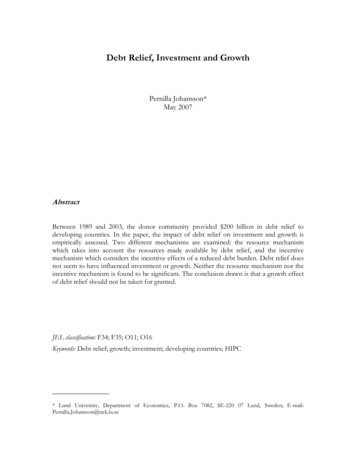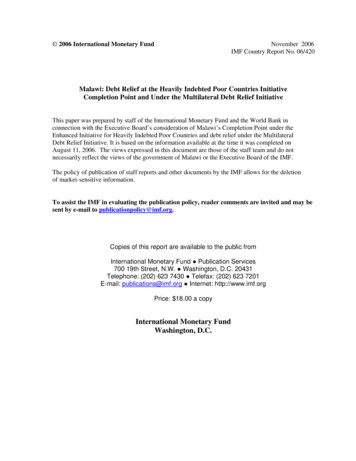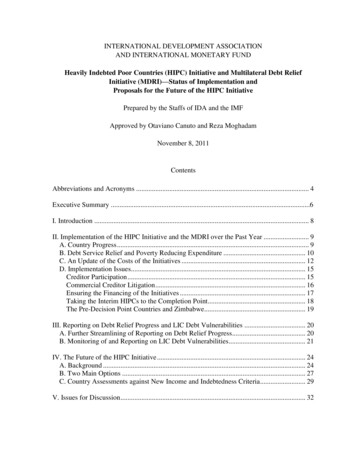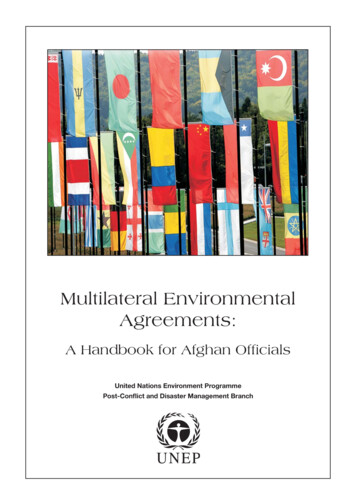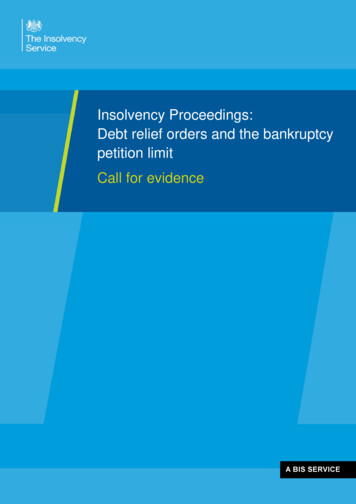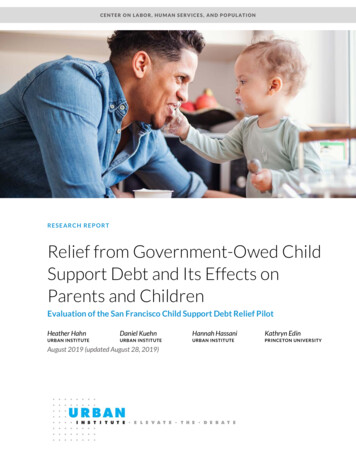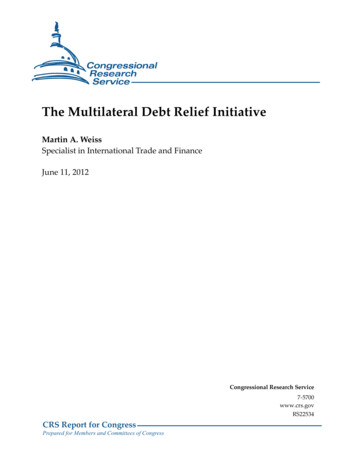
Transcription
The Multilateral Debt Relief InitiativeMartin A. WeissSpecialist in International Trade and FinanceJune 11, 2012Congressional Research Service7-5700www.crs.govRS22534CRS Report for CongressPrepared for Members and Committees of Congress
The Multilateral Debt Relief InitiativeSummaryIn June 2005, G8 finance ministers proposed the new Multilateral Debt Relief Initiative (MDRI).The MDRI proposes to cancel debts of some of the world’s poorest countries owed to theInternational Monetary Fund, World Bank, and African Development Bank. This report discussesMDRI’s implementation and raises some issues regarding debt relief’s effectiveness as a form offoreign assistance for possible congressional consideration. It will be updated as events warrant.Congressional Research Service
The Multilateral Debt Relief InitiativeContentsPast Debt Relief Efforts. 1Bilateral Debt Relief. 2HIPC Debt Relief . 2MDRI Debt Relief . 3MDRI Implementation . 3Policy Issues . 4TablesTable 1. Countries Eligible for HIPC Debt Relief (As of 06/2012). 3ContactsAuthor Contact Information. 6Congressional Research Service
The Multilateral Debt Relief InitiativeThe Multilateral Debt Relief Initiative (MDRI) is the most recent effort by the InternationalMonetary Fund (IMF), World Bank, and African Development Bank (AfDB) to providepoor country debt relief. Proposed by G8 finance ministers in June 2005, the MDRIprovides 100% debt relief to select countries that are already participating in the joint-IMF/WorldBank Heavily Indebted Poor Countries (HIPC) program.1 The goal of the MDRI program is tofree up additional resources for the poorest countries in order to help them reach the UnitedNations’ Millennium Development Goals (MDGs), which are focused, among other things, onreducing world poverty by half by 2015.2There are several key features of the MDRI: All pre-existing IMF, World Bank, and AfDB debt will be cancelled for anycountry that completes the HIPC program. (The Asian Development Bank, InterAmerican Development Bank, and other development banks are not participatingin the Initiative.)3 The MDRI Agreement provides no additional net assistance. HIPC countries thatreceive debt reduction will have their total assistance flows from the agencycanceling their debt reduced by the amount of debt forgiven. The IMF will internally fund its debt relief while the World Bank and AfDB willbe compensated by G8 donors. IMF debt relief will be funded with the moneyobtained from the sale of some IMF gold in the late 1990s.The MDRI raises several questions for policy makers: What is the effect of debt on the poorestcountries? What impact can the MDRI be expected to have on poverty reduction? What policiescould make debt relief more effective?Looking at several studies of the effectiveness of the HIPC program from 1996-2006, it appearsthat although debt relief can slightly increase the amount of financial resources available to poorcountries, the debt burden is not the main impediment to poverty reduction and economic growthin the poorest countries. Weak macroeconomic institutions and difficulty absorbing foreignassistance, as well as political challenges, appear more likely hurdles. Alleviating the debt burdenin the absence of other strategic reforms is unlikely to substantially contribute to improvedconditions in the poorest countries. If combined with other efforts, however, debt relief can have acomplementary effect on domestic government finances and can help promote further reform.Past Debt Relief EffortsThe MDRI builds on several bilateral and multilateral debt relief initiatives conducted over thepast twenty years. In the 1980s and early 1990s, as the debts of the poorest countries increasedrapidly compared to other low-income countries, the G7 and other creditor countries implementedseveral plans aimed at reducing the countries’ debt payment burden.1See CRS Report RL33073, Debt Relief for Heavily Indebted Poor Countries: Issues for Congress, by Martin A.Weiss.2The Millennium Development Goals Report 2006, United Nations, New York, 2006.3In November 2006, the Inter-American Development Bank separately announced that it agreed to provide 100% debtrelief to five Latin American HIPCs: Bolivia, Guyana, Haiti, Honduras, and Nicaragua. Bachelet, Pablo. “IDB OK’smassive debt relief package for five nations,” Miami Herald. November 18, 2006.Congressional Research Service1
The Multilateral Debt Relief InitiativeBilateral Debt ReliefIn 1988, in response to a G7 initiative, a group of major creditor nations, known as the Paris Club,agreed for the first time to cancel debts owed to them by up to one-third instead of refinancingthem on easier terms as they had done previously.4 Over the next decade, the Paris Club graduallyincreased the amount of debt that it would be willing to write off by up to 90% in 1999. TheUnited States did not participate in the initial debt forgiveness plans, but in 1991, at the initiativeof Congress, independently forgave almost all of the debt owed to it by the poorest nations. Since1991, the United States has forgiven 23.9 billion in foreign debt.5HIPC Debt ReliefThe IMF and World Bank introduced debt relief in 1996 through the Heavily Indebted PoorCountry (HIPC) Initiative. When conceived, the intention of the program was to reduce poorcountries’ debts to a so-called “sustainable” level. Sustainability was defined as multilateral debtsnot exceeding a maximum debt-to-exports ratio of 250%. In 1999, the program was redesigned inresponse to criticism that the debt-to-export ratio was too large, disqualifying many countriesfrom debt relief. The target debt service-to-exports ratio was reduced to 150%, and the timeperiod for eligibility was shortened. The HIPC program was also modified to require increasedpoverty reduction efforts. Any money freed up by debt relief must now be used explicitly onpoverty reduction efforts.HIPC debt relief is provided in stages, based on each country’s performance against a defined setof economic targets and requirements. HIPC-eligible countries must successfully implementIMF-proscribed reforms for three years before reaching the “decision point” and receivingintermediate debt relief. Following a further track record of good economic policy, a countryreaches “completion point” where the remaining debt relief is granted. Table 1 shows the currentstatus of countries in HIPC initiative.4See CRS Report RS21482, The Paris Club and International Debt Relief, by Martin A. Weiss.U.S. Treasury Department and the Office of Management and Budget. U.S. Government Foreign Credit Exposure asof December 31, 2005, Part I, p. 19.5Congressional Research Service2
The Multilateral Debt Relief InitiativeTable 1. Countries Eligible for HIPC Debt Relief (As of 06/2012)Completion Point(32 countries)AfghanistanBeninBoliviaBurkina FasoBurundiCameroonCentral AfricanRepublicRepublic ofCongoDemocratic Rep.of CongoEthiopiaThe igerRwandaSao Tome & PrincipeSenegalSierra LeoneTanzaniaUgandaZambiaDecision Point(2 countries)ChadCote d’IvoireComorosGuineaPre-Decision Point(3 countries)EritreaSomaliaSudanSource: World Bank.MDRI Debt ReliefThe eventual MDRI agreement was a compromise agreement between the United States and theEuropeans. U.S. officials had reportedly argued that the cost of multilateral debt relief could beborne by the institutions and did not require donors’ contributing any new assistance. Othercreditors believed the institutions should be compensated for their debt forgiveness to avoiddiverting potential resources that could be lent to the poorest countries. Any debt relief, theyargued, should be additional to existing multilateral assistance. The compromise plan entailed themultilateral development banks receiving new money from creditor nations to offset their debtreductions while the IMF would absorb the cost of debt relief using internal resources.6MDRI ImplementationThe IMF was the first of the participating institutions to implement its MDRI debt relief. UnderMDRI, the IMF is cancelling all HIPC debt incurred by year-end 2004. In addition to the eligibleHIPC countries, the IMF expanded MDRI to all IMF members with per capita incomes of 380or less. Two non-HIPC countries—Cambodia and Tajikistan—have qualified for MDRI debtrelief. To date, the IMF has provided MDRI debt relief to 21 countries, totaling 3.67 billion. TheIMF expects that total MDRI debt relief will be around 5 billion if all eligible countriescomplete the program.Unlike the IMF, both the World Bank and the Asian Development Bank are only providing MDRIrelief to HIPC completion point countries. Only debts accrued prior to year-end 2003 are eligible6Eric Helleiner and Geoffrey Cameron, “Another World Order? The Bush Administration and the HIPC DebtCancellation,” New Political Economy, Vol. 11, No. 1, March 2006.Congressional Research Service3
The Multilateral Debt Relief Initiativefor World Bank/AfDB MDRI debt relief. If fully implemented, the World Bank will provideabout 37 billion in debt relief. African Development Bank debt relief would be 8.5 billion.Policy IssuesThere are numerous reasons why policy-makers support poor country debt relief. Debt reliefemerged as a foreign policy issue mainly through moral arguments against requiring the poorestcountries to repay their debts. At a United Nations conference on Africa in 2004, ColumbiaUniversity professor and United Nations advisor Jeffrey Sachs remarked: “No civilized nationshould try to collect the debts of people who are dying of hunger and disease and poverty.”7Others, including the Bush Administration, presented what they viewed as a pragmatic argumentfor debt relief. They argued that debt was “locking these poorest countries into poverty andpreventing them from using their own resources [for development].”8 By providing debt relief,they argued, resources that would have been allocated for debt repayments would now beredirected toward new investment and/or domestic social services. At a press release announcingthe MDRI deal, former World Bank president Paul Wolfowitz announced that, “across Africa andaround the world, leaders in 38 countries will no longer have to choose between spending tobenefit their people and repaying impossible debts.”9Recent studies cast doubt, however, on debt relief’s contribution to larger development andpoverty reduction goals. These studies argue that poor underlying economic and politicalconditions are the main reason for the HIPCs’ poor performance. In light of this research,Congress may wish to explore in more depth what effect debt has on poor countries’ economiesand under what conditions debt relief can help promote economic growth and poverty reduction.Historically, policymakers and academics viewed high levels of debt as a constraint on economicgrowth. It was argued that as long as investors expected a country’s debt level to impair its abilityto repay its loans—its “debt overhang”—investors would abstain from entering a country out of aconcern that the government may resort to distortionary or inflationary measures, such asexpanding the money supply or raising taxes on their profits, to finance debt payments. Even ifthe debt is not being serviced, the theory suggests that it is still an impediment to economicgrowth because of the effect the large debt stock has of dissuading private investors. In a debtoverhang situation, the appropriate policy response is to forgive the debt, either entirely or tosome “sustainable” level so that investor confidence will be restored.10 Debt overhang theory wasinstrumental in driving the development of the HIPC program. Over time however, it becameapparent that the theory was not especially well suited for the poorest countries, which relied onforeign assistance, rather than private investment, as their key source of foreign capital.7Quoted in “Is There a Way Out of the Debt Trap?” International Food Policy Research Institute Forum, December2004.8Quoted in Paul Blustein, “Debt Cut Is Set for Poorest Nations—Deal Would Cancel 40 Billion in Loans,” TheWashington Post, June 12, 2005.9International Monetary Fund & World Bank Development Committee Press Briefing, September 25, 2005.10Paul Krugman, “Financing vs. Forgiving a Debt Overhang.” Journal of Development Economics, vol. 29, 1988, pp.253-268; and Jeffrey Sachs, “The Debt Overhang of Developing Countries,” in Guillermo A. Calvo and others, eds.,Debt Stabilization and Development, Essays in Memory of Carlos Dias Alejandro, Oxford, U.K.: Basil Blackwell,1989.Congressional Research Service4
The Multilateral Debt Relief InitiativeAccording to the World Bank’s 2006 evaluation of the HIPC program, debt relief alone is notsufficient for debt sustainability in the poorest countries. Under HIPC, 18 countries had their debtlevels reduced to half their initial levels, cancelling 19 billion of external debt. However, in 11out of the 13 countries (with data available), the debt situation has worsened. In 8 countries, debtlevels once again exceed HIPC thresholds.11Several reasons may explain this situation. First, the concepts of “sustainable debt” and “debtoverhang” may be inappropriate for the HIPC countries. Earlier debt overhang models weredesigned with middle-income countries in mind, which were suffering under heavy nonconcessional private debt. For example, when financial crises hit Latin American countries in the1980s, their debts were resolved under the “Brady Plan” (negotiated by former Secretary of theTreasury Nicholas Brady). The forgiveness of debt amounted to 60 billion, after which, privatecapital surged into the Brady countries. These countries received 210 billion dollars in netcapital flows in the five years following their debt write-off.12In the case of the HIPC countries, investors were more likely to stay away for other reasons, suchas political and economic instability, rather than any concerns about indebtedness per se.Moreover, unlike other debtor nations, bilateral and multilateral HIPC debt is highly concessional(i.e., inexpensive) compared to private sector debt. Foreign aid providers have not stopped theiraid just because they are not being repaid 100% on their bilateral debt. Moreover, the inflow offoreign aid funds is typically more than sufficient to cover debt payments, so the cost of debtservice is effectively borne by the donor countries rather than by the debtors.Secondly, there are additional factors, unique to the poorest countries, that may promote increasedindebtedness. Since their debt is highly concessional, there may be a perverse incentive forcountries not to grow in order to remain eligible for multilateral assistance. Preliminary evidencelooking at 94 countries (33 of which are low income) over 1988-2000 found evidence of thiseffect. A significant number of countries appeared to stagnate around the income level thatdefined eligibility for concessional assistance. Above the cutoff level, countries would no longerbe able to receive concessional aid. By diverting their assistance away from investment towardconsumption they were able to hover just below the eligibility cutoff.13The impact of MDRI debt relief will likely be modest at best. First, by definition, MDRI debtrelief does not increase the overall resources available to poor countries. Any debt relief that acountry receives results in a net decrease in future multilateral aid resources allocated. Second,the amount of debt relief provided by MDRI is small. In the case of the 15 African HIPCs, onaverage, they paid 19 million in debt service to the World Bank in 2004. That same year, theyreceived 197 million in new World Bank aid and 946 million in total aid.14 Any debt relief,even if it were in addition to existing foreign aid, would provide only a minuscule increase indomestic resources. Thus it appears that debt relief can have its largest impact if it is situated as11Debt Relief for the Poorest: An Evaluation Update of the HIPC Initiative, The World Bank Independent EvaluationGroup, 2006.12Serkan Arslanalp and Peter Blair Henry, “Helping the Poor to Help Themselves: Debt Relief or Aid?” in SovereignDebt at the Crossroads, edited by Chris Jochnick and Fraser A. Preston. Oxford University Press, 2006.13Junko Koeda, “A Debt Overhang Model for Low Income Countries: Implications for Debt Relief,” InternationalMonetary Fund Working Paper WP/06/224, October, 2006.14Todd Moss, “Will Debt Relief Make a Difference? Impact and Expectations of the Multilateral Debt ReliefInitiative,” Center for Global Development Working Paper Number 88, May 2006.Congressional Research Service5
The Multilateral Debt Relief Initiativepart of a broader package of reforms that include, among other things, increased debtmanagement capacity, and targeted growth enhancing changes in national policy.15Author Contact InformationMartin A. WeissSpecialist in International Trade and Financemweiss@crs.loc.gov, 7-540715CRS Report RL30449, Debt and Development in Poor Countries: Rethinking Policy Responses, by J. F. Hornbeck.Congressional Research Service6
relief. To date, the IMF has provided MDRI debt relief to 21 countries, totaling 3.67 billion. The IMF expects that total MDRI debt relief will be around 5 billion if all eligible countries complete the program. Unlike the IMF, both the World Bank and the Asian Development Bank are only providing MDRI relief to HIPC completion point countries.


